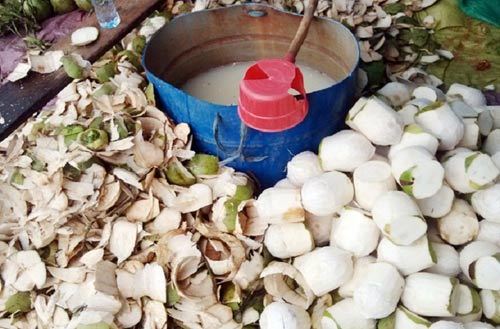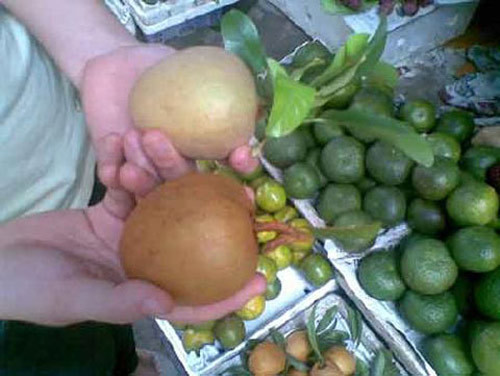How to distinguish ripened fruit
Tips for mothers to distinguish between naturally ripened and artificially ripened bananas, oranges, mangoes, apples...
Fruits are very good for babies and young children because they contain many vitamins and essential nutrients for babies. From the time your baby is 6 months old, you can start introducing your baby to the first fruits such as bananas, avocados, steamed apples, etc.
However, the digestive system of infants and young children is still immature, so fruits for babies must be chosen in season, and should be purchased fresh and especially, not forced ripened or soaked in toxic chemicals.
How to choose clean and safe fruits for your children is a problem that makes many women worry. Please tell mothers how to distinguish between naturally ripened and artificially ripened fruits for your children.
Banana
Bananas are a fairly common fruit and are widely available. Babies who are just starting to eat solid foods often love bananas because of their natural sweetness and softness. A banana has up to 400mg of potassium, which is enough for a baby's potassium needs in a day. In addition, bananas contain a lot of vitamins and have a very strong antioxidant effect, so they help strengthen the body's immune system and effectively prevent constipation.
Unlike other fruits, bananas are very safe and extremely convenient. No need for knives or washing, just peel them with your hands and let your baby enjoy them immediately. However, bananas are also a fruit that is often ripened by chemical vinegar.
Chemically ripened bananas have a nice, even yellow body, but the stem is still green and the tip is still sticky. When peeled and eaten, the banana flesh is still hard, like eating raw rice.
Naturally ripened bananas will ripen from the base and will not have this phenomenon.
 |
| Bananas ripened by chemical means have a beautiful, evenly golden yellow body, but the stem and top remain green. Bananas ripened naturally will ripen from the stem (illustrative photo) |
Orange
Oranges are one of the fruits with very high nutritional value. On average, every 100g of orange contains 87.6g of water, 1,104 micrograms of Carotene - an antioxidant vitamin and 30mg of vitamin C to help children effectively increase their resistance.
To keep oranges fresh for a long time, many traders inject preservatives into the fruit. In addition, the surface of the orange is often very shiny and sticky, with a dark yellow color, patchy and uneven. Meanwhile, a naturally ripe orange has an even yellow color from top to bottom.
 |
| Oranges injected with preservatives have a mottled yellow color and are less juicy when cut. (illustrative photo) |
Mango
Mangoes contain most of the vitamins A, C, E and K as well as many other nutrients such as fiber, magnesium and potassium. Therefore, mangoes are a great fruit to include in your baby's weaning diet.
However, mothers should also know how to choose mangoes carefully. Mangoes with green or pale yellow-green skin on the outside, but the inside is ripe yellow and has no mango flavor, bland, and is often soaked with a lot of preservatives.
 |
| Mangoes are forced to have green skin but rotten flesh. Mangoes are naturally ripe with yellow skin and yellow flesh. (illustrative photo) |
Jackfruit
Jackfruit is rich in important nutrients such as vitamin A, vitamin C, calcium, potassium, iron, thiamin, riboflavin, niacin, magnesium and many other nutrients that help boost the immune system and provide energy for children. However, the phenomenon of jackfruit ripened by chemical soaking is very common today.
Jackfruit ripened with chemicals is less fragrant and often hard (seller calls it crispy), the fiber is also very yellow, the stem is still green, very different from tree-ripened jackfruit which usually has bright yellow, fragrant segments; the fiber is white or light yellow.
 |
| Ripe jackfruit has yellow fibers and is sweet like segments. Natural jackfruit has white or light yellow fibers (illustrative photo) |
Coconut
Around 6-7 months old, babies can get used to coconut water but in small amounts and at reasonable frequency. Coconut water is rich in lauric acid - a fatty acid found in breast milk, very good for the baby's digestive system, strengthens the immune system and protects the baby from infectious diseases.
Nowadays, coconuts are often “magically” transformed into “genuine” coconuts to increase profits for sellers. Chemical sugars and aromatic chemicals are injected through the germ hole on the top of the coconut, turning the sour young coconut water into a sweet one, or to keep the coconut white, just soak the coconut in water mixed with a little Javen.
To avoid toxic contamination, if you notice that the coconut has a strange aroma or a strong sweet taste, you should be careful not to let your child drink it because coconut water is usually sweet and refreshing. With the naked eye, you can also see if the germ hole on the top of the coconut is open or not. It is best to buy fresh coconuts that still have their green shell intact.
 |
It's best to choose fresh coconuts that still have their hard green shell intact to avoid buying bleached, sugar-injected coconuts. |
Sapodilla
Crushed ripe sapodilla is a fruit that mothers can feed their babies when they are 6 months old. Ripe sapodilla contains many substances such as protein, glucid, cellulose, phosphorus, and vitamin C which are good for babies.
To make the sapodilla more attractive, sellers often soak the fruit in a solution believed to be iron powder mixed with water. Sapodillas with a deep yellow color have been soaked in iron powder, while sapodillas with green veins visible through the thin skin have not been soaked.
 |
The dark yellow sapodillas have been soaked in iron powder, while the sapodillas that still have green veins through the thin skin have not been soaked. |
Cherry
Feeding cherries to children is currently a trend in big cities because many people believe that cherries are not only delicious and eye-catching, but also rich in nutrients and antioxidants for children. The price of cherries in Vietnam is not cheap, but even when buying expensive, many mothers still risk buying cherries soaked in chemicals.
Australian cherries are a bit darker red, crunchy and sweet, while Chinese cherries are softer, blander and more salty. Also, when you buy cherries, try putting them in a plastic bag and pinching it shut for a moment, then opening it and smelling it. If there are any chemical residues, it will have a slightly pungent smell.
 |
Australian cherries are a bit darker red, crunchy and sweet, while Chinese cherries seem softer, blander and more salty. |
According to Khampha
